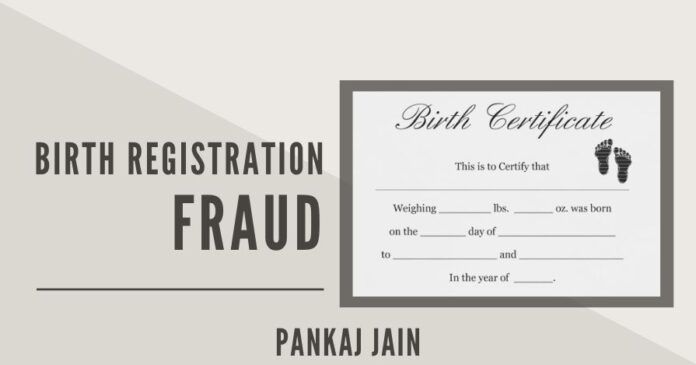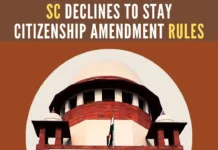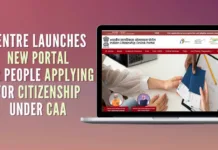
It is extremely tough for anyone to find them to be fake – they appear as authentic as any true government identity document
Just before our country got consumed in its fight against COVID-19, for many months it was obsessed with CAA and NRC. The fear-mongers were having a field day – spreading fear, faster than any virus can spread, that these were fatal attacks on our secular constitution and the precursor to the fascist pogrom against a certain community. The news spread that under these acts, the government would inspect your papers and if it found that you were not born in India and belonged to a certain community, then you would be thrown out of the country. “Kagaz nahi dikhayenge” became for this community, perhaps what “Vande Matram” was for our freedom fighters.
The purpose of this series is not to go into the merits of the CAA or NRC, or even to delve into the ensuing paranoia. The sole purpose is to show how this paranoia was much ado about nothing. For it is elementary, in India, to get the “papers” that suit you – as easy as it is to buy wine in California! To top it up, these “papers” are backed with entries in the relevant government registers and documents, and thus it is extremely tough for anyone to find them to be fake – they appear as authentic as any true government identity document could and are issued through the designated government machinery. In a sense, they are “false” and not “fake.” So there is absolutely no reason for any community to fear. Given this state of affairs, the government, on its part, is also unlikely to achieve anything worthwhile from the costly exercise of NRC, no matter how noble its intentions are unless it fixes this menace. It makes me wonder why we had all those traffic snarls in Delhi due to Shaheen Bagh!
Birth registration is also crucial for public policy, most notably in the health sector. The census happens once in a decade. So the birth and death registrations – i.e. the Civil Registration System (CRS) is vital in keeping our national statistics updated.
In this series, we shall uncover the large scale birth registration fraud that is pandemic across the country. A birth certificate is the first identity document a citizen of our country gets and entitles it to a plethora of benefits. It also acts as the basis of other identity documents. So any lacuna in the birth registration system makes the NRC exercise futile.
Let us begin with some background information:
The Birth Registration 101
Birth registration is compulsory in India – in fact, it is right of every child to be identified soon after its birth. The birth certificate is the first legal document confirming the identity of every individual. The then President of India, Dr. A P J Abdul Kalam, while launching the National Campaign for Birth Certificates on 14th November 2003 stated:
“Children are our greatest wealth. Every child born in the nation should be allowed to blossom. This is the responsibility of the state. To enable us to fulfill this responsibility the first action is the identification of the child soon after its birth.”
The birth certificate is the definite proof of date of birth, parentage, and also the place of birth. It confers several rights and benefits on the citizen – it (and its derivatives) is used:
- For Admission to schools
- To get benefits of the Juvenile Justice Act (remember how one of the accused escaped gallows in the Nirbhaya Rape case)
- As proof of age for employment and retirement (and thus determines the tenure of employment)
- For proof of age at marriage
- For obtaining a driving license
- For participation in an age-restricted competition
- To establish parentage
- To establish the place of birth, and hence become eligible for benefits offered by the state governments
- To establish age for purpose of enrollment in Electoral Rolls or showing eligibility to contest elections
- In obtaining other government identity documents such as Passport and Aadhar card
- The list goes on…
The birth certificate is going to be the most important document in the NRC exercise, if and when it is launched.
Unfortunately, it is in a complete state of a mess as unscrupulous operators, which includes not just Dallas (agents) but also government officials and ordinary citizens, have thoroughly gamed the birth registration mechanism.
Birth registration is also crucial for public policy, most notably in the health sector. The census happens once in a decade. So the birth and death registrations – i.e. the Civil Registration System (CRS) is vital in keeping our national statistics updated. Indeed the CRS provides vital statistics that guide the formulation and monitoring of the public health interventions. The CRS data is critical incapacity planning and monitoring the coverage and outcomes of the nutrition and immunization program. The author has been closely associated with the national program for the treatment of clubfoot in children, and that program can definitely improve dramatically if accurate and detailed data on births are made available. Even data such as births at homes (extra-mural) versus births at hospitals (intra-mural) can be game-changers in public health. The CRS provides metrics such as Birth and Death Rates, Infant Mortality Rate, Maternal Mortality rate, and Sex Ratio, all very vital in public health. Sex Ratio at Birth plays a pivotal role in guiding the “Beti Bachao, Beti Padao” initiative.
Thus, it is needless to say that CRS data is a national asset and it is paramount that it is reliable and accurate. Unfortunately, it is in a complete state of a mess as unscrupulous operators, which includes not just Dallas (agents) but also government officials and ordinary citizens, have thoroughly gamed the birth registration mechanism. In this series, we will uncover one method by which false birth registrations are being done in mindbogglingly large numbers. The net result is that the CRS data is of limited practical use, and the government has to rely on an alternative, aptly named Sample Registration System (SRS). It is shocking that we don’t even have an accurate estimate of our country’s population.
The Act
The birth registration is governed by the provisions of The Registration of Births and Deaths Act, 1969. Section 30 of this Act provides for the states to formulate their own rules. The states have generally adopted the model rules suggested by the union government’s Model Registration of Births and Deaths Rules, 1999.
As per this Act and the associated Rules, it is mandatory to report a birth within 21 days of its occurrence. The hospital authorities are responsible for the births happening in a hospital (intra-mural) within this time-frame, and there is a penalty for non-compliance. Likewise, the head of the household is responsible for reporting any birth happening at home (extra-mural) within this time period.
If for some reason a birth is not reported and registered within 21 days, the section 13 of the Act allows for late registration, and has rules for registration within 21 to 30 days, 30 days to 1 year, and after 1 year of the occurrence of the birth. Subsection 13(3) of the Act and 9(3) of the Rules govern the registration of birth which is reported after a year of its occurrence. It allows for such a birth registration only on an order by the Sub Divisional Magistrate (SDM) of the area. The SDM can issue such a delayed birth registration order after ‘verifying’ the correctness of birth.
The Fact
In practice, in many jurisdictions, such SDM orders for delayed birth registration are issued without any verification. The Union Government has not specified any guidelines or procedures for verification by SDM prior to issuing a delayed birth registration order and has left it to the discretion of the SDM to do appropriate verification on a case by case basis. This was revealed to the author by the Registrar General of India in a response to an RTI.
This has resulted in a massive number of delayed birth registration orders being issued by SDMs based on plain statements on affidavits by the applicants and without any verification. A parent can just state on an affidavit that a child was born on a particular day (several years back), and at home, and that the parent forgot to report the birth. That’s it! SDM issues a delayed birth registration order, without any verification. Once the SDM issues a delayed birth registration order, the concerned registrar does the birth registration without asking any question – and one can have a birth certificate with any name, date of birth, parentage, place of birth and religion. There has been a large scale abuse of this lacuna to get false birth registrations done on a large scale across the country. Since these birth registrations are done by making proper entries in the birth register, it is next to impossible for anyone to find that these are fraudulent birth registrations. There is no need to forge birth certificates or registrar seals. This is a foolproof and extremely low-risk way to get fraudulent birth certificates that are “authentic” for all practical purposes. The whole process takes a few hours and about a grand of cash.
The author also checked with the state registration authorities about the verification process prior to the issue of the delayed birth registration orders. The Chief Registrar, Uttar Pradesh has informed that there are no guidelines for the verification by the SDM. It has further stated that it is the responsibility of the registrar to do the verification of the correctness of the reported birth (even a delayed birth report). The author also enquired about what action is taken if a birth registration is found to be fraudulent. The authorities have informed that it is the responsibility of the concerned registrar to investigate and cancel fraudulent birth registrations. But that seldom happens.
However, as we will see in the next few episodes in this series how the above loophole in the delayed birth registration process and the ping pong game between the SDM and registrar, have been exploited to get fraudulent birth certificates with impunity and the concerned authorities have been extremely lackadaisical in taking action against such acts of fraud.
Note:
1. The views expressed here are those of the author and do not necessarily represent or reflect the views of PGurus.
- Allahabad to Prayagraj to Allahabad - September 4, 2020
- The Curious Case of Azam Khan’s Hindu son - August 18, 2020
- The AllahaBAD born identity - August 12, 2020











Informative and useful
[…] previous parts of the article can be accessed here 1, 2. This is part […]
[…] previous part of the article can be accessed here. This is part […]